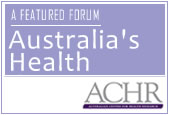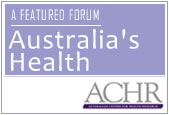Remedy Healthcare and Health Reform
Open Forum | January 14, 2010

This speech was presented by John Meckiff at the GAP/ACHR Congress on Australia’s Health on Monday 30 November 2009.
Good afternoon.
In order to give you some context, Remedy Healthcare is a disease management business which delivers telephone based self management and home based allied health services to patients diagnosed with chronic disease. Remedy operates in an environment directly impacted by the recommendations of the National Health & Hospitals Reform Commission (NHHRC) final report.
Before I discuss how health reform will or could influence the kinds of post acute care services we offer, I want to start with a case study.
In March 2009, a member of Australian Unity was recruited into the Remedy Healthy Heart Program following discharge from hospital after an exacerbation of her condition. The Healthy Heart Program is designed to improve the ability of patients to self manage their disease, in this instance, Heart Failure. The patient was fully assessed in relation to her medical history, signs and symptoms, medications, and health literacy etc, and a care plan automatically developed to enable her to understand the routines and behaviours she needed to adhere to in order to keep herself well.
 Two weeks later, she received a second call in the program from on of our nurses, where after an initial progress assessment, it was clear that her condition had deteriorated rapidly over the preceding 24 hour period. She complained of increasing shortness of breath, fatigue and leg swelling… all symptoms of acute heart failure. Our nurse immediately called her GP and arranged an urgent appointment. The GP prescribed her with a diuretic and some additional changes were made in the dosages of her existing medications. She remained at the clinic for around two hours, and was subsequently sent home with a follow up appointment scheduled the next day. In this case, it was likely that our timely intervention had assisted in avoiding presentation to an Emergency Department and likely hospital admission.
Two weeks later, she received a second call in the program from on of our nurses, where after an initial progress assessment, it was clear that her condition had deteriorated rapidly over the preceding 24 hour period. She complained of increasing shortness of breath, fatigue and leg swelling… all symptoms of acute heart failure. Our nurse immediately called her GP and arranged an urgent appointment. The GP prescribed her with a diuretic and some additional changes were made in the dosages of her existing medications. She remained at the clinic for around two hours, and was subsequently sent home with a follow up appointment scheduled the next day. In this case, it was likely that our timely intervention had assisted in avoiding presentation to an Emergency Department and likely hospital admission.Although this is an elegant case study which demonstrates what can be achieved with telephone support, in reality the outcome was more about luck than science. We just happened to call at the right time; we were able to arrange access to the GP and the patient responded to pharmacological treatment ……… with a $6000-$7000 hospital admission was avoided.
We estimate scenarios like this are likely to happen once every 150-200 calls, particularly as most of our calls are outbound and planned in accordance with the patient’s condition and propensity to ‘engage’ with the concept of self management and behavioral change. That said, the purpose of what we do is to improve health, quality of life and for our customer in this case (Australian Unity) to reduce secondary hospitalisation events. , so this was a small win, with a few high fives around the office at the time.
The evidence
It’s instructive to review the evidence for managing patients with chronic heart failure in relation to a reduction in all cause hospital admissions… as this evidence will inform us of the types of services which are required to adequately address the growing numbers of patients living with chronic and complex diseases.
Numerous randomised controlled studies conducted to evaluate the effectiveness of telephone based self management programs for heart failure have shown you can expect to see an 8-12 percent reduction in all cause hospital admissions. While not a great yield, the results are valid and promote the use of these services.
An RCT study by Murray and cohorts published in the Annals of Internal Medicine in 2007 showed a reduction in all cause admissions following home pharmaceuticals review of 19 percent.
Clarke and cohorts (BMJ 2007) have shown a 21 percent reduction in hospital admissions via remote tele-monitoring with over 4000 patients in the trial.
The evidence becomes far more compelling when we review the results of hybrid studies, where multiple services are provided.
When tele-monitoring is complemented with nurse led home based support, Giordano and cohorts achieved a reduction in secondary hospitalisation of 36 percent (International Journal of Cardiology 2009). Further, when this level of care is complemented by visitation to a multi-disciplinary heart failure clinic (Thomson et al EJHF 2004), a reduction in all cause admissions of up to 45 percent can be achieved.
These numbers strongly support the case for collaborative care.
Need to Collaborate
The numbers of calls which can be economically justified in managing patients with chronic disease are not frequent enough to prevent hospitalisations. We need to invest in collaborative care models which improve the flow of timely information and enable primary care services to react appropriately.
There is compelling evidence, that to be effective, we need to collaborate with other primary care providers including home based nursing services, pharmacists, GPs and specialists within clinics. We know also that we need to collaborate with hospitals and the patient themselves.
These ideas are not new, and in fact, reflect very closely the recommendations made by the NHHRC to address the growing demand for services for patients with chronic disease, particularly the development of what the report refers to as the Health Care Home.
Challenges to Implementation
If we are going to achieve the benefits of collaborative models of care, there are significant barriers which we will need to overcome.
The first of these barriers centre on clinical governance.
Let’s start with hospital admissions. The Australian Institute of Health and Welfare estimates around 9-11 percent of admissions are avoidable. Without access to services in the home, many of these admissions are clinically indicated and therefore rational decisions. To address this, the medical home model will need to be actively marketed to hospitals and integrated in decision making where access is available. Establishment of nursing and allied health services which can be provided in the home would allow many of these avoidable admissions (for example, cellulitis, acute heart failure and pneumonia) to be safely managed in the home.
The next area for addressing clinical governance centres on discharge planning: Using five years of claims data (around 380,000 hospital claims) in the private health system, we identified that patients who present to hospital with acute coronary syndrome have a 52 percent probability of readmission within six weeks. Similarly, for Heart Failure, it’s 42 percent, complications from Diabetes 40 percent and COPD 35 percent. It’s imperative that we address this by recruiting or referring patients from the bedside as these rates are unacceptable. This will require a change in clinical governance practices outside of the classic hospital-GP discharge model, and most likely involve integrated care planning into a multi-disciplinary home services team.
The other opportunity is in use of the Health Care Home model in reducing length of stay. The dividend here could be significant if LOS could be reduced by 10-15 percent, and in part, provide a funding option for the Healthcare Home if the governance principles were adhered to.
We also need to encourage GPs to refer into the Health Care Home model. This may or may not include the provision of the traditional GP home visit, however, it is imperative as GPs are and will continue to be the primary gatekeepers current information required to manage their patient’s health.
The second lot of challenges are structural.
We’ve heard today about the need for a patient controlled electronic health record and more broadly the use of ICT for enabling integrated care. The benefits to enabling the Healthcare Home are significant and well understood with regard to connectivity, but what is more important is that IT be deployed as it should be… not just an electronic means to store information, but as a productivity tool which facilitates the quick distribution of health information and referrals. In addition it must include decision support tools to improve the effectiveness of service delivery as well as facilitating the capture and measurement of clinical outcomes data to ensure we allocate resources to those patients in need most appropriately. Many DM programs run across the country, however, I have not seen any strong evidence that the allocation of resources is based on strong evidence based need. Without measuring and correlating outcomes against interventions, it will continue to be difficult to know if we are providing and rationing the right service to the right people at the right time.
We also need to look to expanding the definition of primary care. Tasmanian Health is reforming their healthcare system in part with development of integrated care centres. This is an innovative approach established to address the need to provide extended and multi-disciplinary consultations to patients with complex chronic conditions.
Finally, we need to get the Funding Models right. What we are building, what we are proposing are new services. The evidence is there, the will is there, businesses and services are being planned and are emerging, just like Remedy to respond to this challenge. We now need the political will now to fund it.
John Meckiff is General Manager of Remedy Healthcare, a preventative healthcare business and wholly owned subsidiary of Australian Unity Limited. John is a qualified Physiotherapist with 10 years clinical experience in both the public and private sectors and also holds an MBA from Melbourne Business School. Prior to his role at Remedy, John was Director of Evidence Based Solutions, a healthcare consultancy and had previously worked as a Manager at Mitchell Madison Group and Deloitte Consulting. Over 8 years, he has consulted to a broad range of clients in healthcare including Sanofi-Aventis, Barwon Health, Western Health, St John of God Hospital, Australian Unity Health, Medibank Private and Cabrini Hospitals. He has also consulted to a broad range of clients in financial services, telecommunications and general insurance.
Remedy Healthcare Group (Remedy) is a preventative health business which provides programs for people diagnosed with chronic disease such as congestive heart failure, osteoporosis and coronary artery disease. The services are delivered to a patient in their home through telephonic, online and personal care programs using nurses, dieticians, physiotherapists and occupational therapists. While wholly owned by Australian Unity, Remedy operates as a separate business entity.
SHARE WITH:
Open Forum is a policy discussion website produced by Global Access Partners – Australia’s Institute for Active Policy. We welcome contributions and invite you to submit a blog to the editor and follow us on Twitter, Facebook, Linkedin and Mastadon.














foggy
January 21, 2010 at 4:52 pm
Telephone support programs